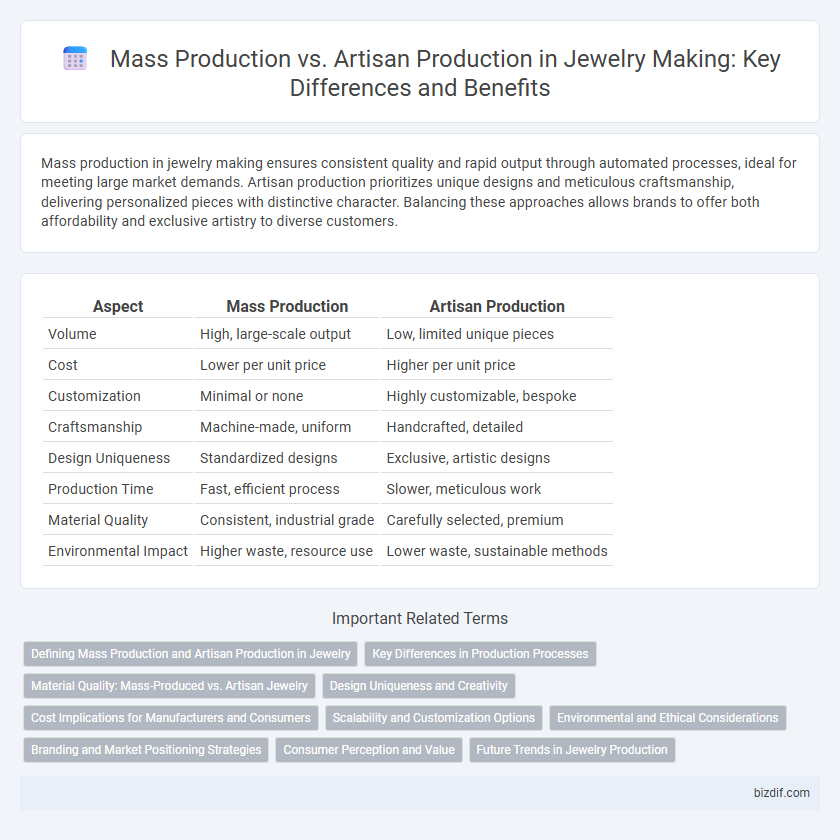Mass production in jewelry making ensures consistent quality and rapid output through automated processes, ideal for meeting large market demands. Artisan production prioritizes unique designs and meticulous craftsmanship, delivering personalized pieces with distinctive character. Balancing these approaches allows brands to offer both affordability and exclusive artistry to diverse customers.
Table of Comparison
| Aspect | Mass Production | Artisan Production |
|---|---|---|
| Volume | High, large-scale output | Low, limited unique pieces |
| Cost | Lower per unit price | Higher per unit price |
| Customization | Minimal or none | Highly customizable, bespoke |
| Craftsmanship | Machine-made, uniform | Handcrafted, detailed |
| Design Uniqueness | Standardized designs | Exclusive, artistic designs |
| Production Time | Fast, efficient process | Slower, meticulous work |
| Material Quality | Consistent, industrial grade | Carefully selected, premium |
| Environmental Impact | Higher waste, resource use | Lower waste, sustainable methods |
Defining Mass Production and Artisan Production in Jewelry
Mass production in jewelry involves creating large quantities of standardized pieces using machinery and assembly line techniques to ensure uniformity and lower costs. Artisan production emphasizes handcrafted, unique designs made by skilled jewelers, highlighting craftsmanship and individualized detail. The distinction lies in scalability and customization, where mass production targets efficiency and consistency, while artisan production values exclusivity and artistic expression.
Key Differences in Production Processes
Mass production in jewelry making relies on automated machinery and standardized molds, enabling the creation of large quantities with consistent quality and lower costs per unit. Artisan production emphasizes handcrafted techniques, where skilled jewelers shape and assemble each piece individually, resulting in unique designs and intricate detailing. The key difference lies in scalability and customization: mass production prioritizes efficiency and uniformity, while artisan methods focus on craftsmanship and exclusivity.
Material Quality: Mass-Produced vs. Artisan Jewelry
Mass-produced jewelry often uses lower-cost materials such as plated metals and synthetic stones to keep prices competitive, which can compromise long-term durability and aesthetic appeal. Artisan jewelry emphasizes high-quality, often rare or ethically sourced materials like solid gold, silver, and natural gemstones, enhancing both value and uniqueness. The meticulous selection of premium materials in artisan pieces reflects craftsmanship that prioritizes longevity and individuality over volume.
Design Uniqueness and Creativity
Artisan production in jewelry emphasizes design uniqueness and creativity, often resulting in one-of-a-kind pieces that showcase intricate craftsmanship and personalized artistry. Mass production focuses on uniformity and efficiency, producing large quantities of jewelry with standardized designs that lack individual character. The distinctiveness of artisan jewelry appeals to consumers seeking exclusive and innovative styles not found in mass-produced collections.
Cost Implications for Manufacturers and Consumers
Mass production in jewelry making significantly lowers manufacturing costs by utilizing automated processes and bulk materials, enabling economies of scale that reduce prices for consumers. Artisan production, relying on skilled craftsmanship and individual design, incurs higher labor costs and longer production times, resulting in premium pricing for unique, handcrafted pieces. Consumers choosing mass-produced jewelry benefit from affordability and consistency, while those opting for artisan pieces invest in exclusivity and craftsmanship, reflecting greater value and customization.
Scalability and Customization Options
Mass production in jewelry making enables high scalability by producing large quantities of uniform pieces efficiently using automated processes and molds. Artisan production offers extensive customization options through handcrafting techniques, allowing for unique, personalized designs tailored to individual preferences. While mass production excels in meeting high demand with consistent quality, artisan production prioritizes creative expression and bespoke craftsmanship.
Environmental and Ethical Considerations
Mass production in jewelry making often relies on synthetic materials and large-scale mining, leading to significant environmental degradation and carbon emissions. Artisan production emphasizes sustainable sourcing, using recycled metals and ethically mined gemstones to minimize ecological impact. Ethical considerations also favor artisans who ensure fair labor practices and support local communities, contrasting with the exploitative conditions sometimes found in large factories.
Branding and Market Positioning Strategies
Mass production in jewelry making leverages consistent quality and cost efficiency to target broad market segments, emphasizing brand recognition through large-scale advertising and competitive pricing. Artisan production prioritizes unique craftsmanship and limited editions, cultivating brand identity centered on exclusivity, heritage, and personalized customer experiences. Strategic market positioning for mass producers often highlights affordability and trend responsiveness, while artisan jewelers focus on authenticity, storytelling, and niche appeal to differentiate their brand.
Consumer Perception and Value
Mass-produced jewelry appeals to consumers seeking affordability and consistency, often perceived as less unique but reliable in quality. Artisan jewelry attracts buyers who value craftsmanship, originality, and the story behind each piece, enhancing emotional connection and perceived exclusivity. Consumer perception heavily influences value, with artisan items typically commanding higher prices due to their uniqueness and detailed workmanship.
Future Trends in Jewelry Production
Future trends in jewelry production emphasize the integration of advanced technologies such as 3D printing and AI-driven design to enhance mass production efficiency while maintaining customization options. Artisan production increasingly leverages digital tools to preserve craftsmanship authenticity, enabling limited-edition and bespoke pieces that cater to niche markets. Sustainable practices and ethical sourcing are becoming central, pushing both mass and artisan producers to innovate with eco-friendly materials and transparent supply chains.
Mass production vs Artisan production Infographic

 bizdif.com
bizdif.com